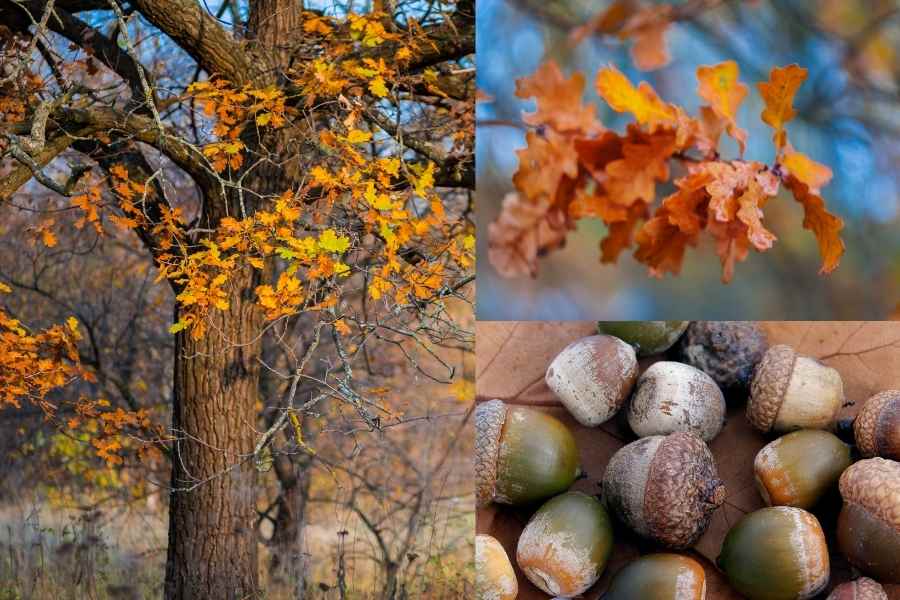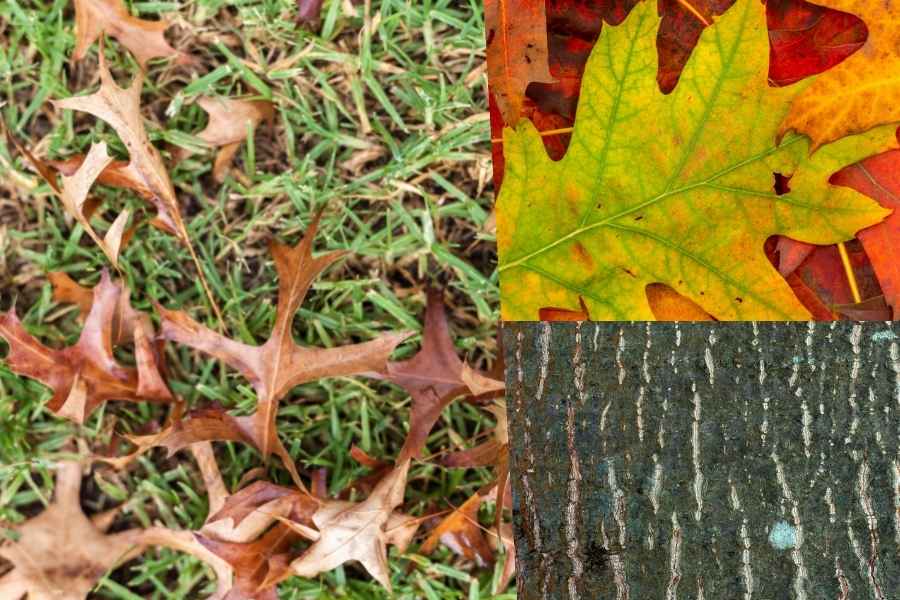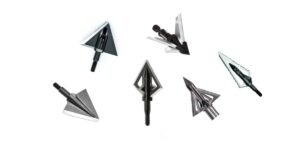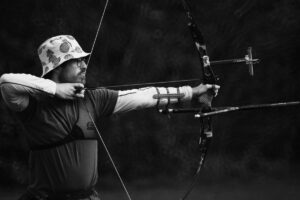When you’re crouched down as you hunt, it’s easy for all trees to look alike. But deers love a variety of different trees, and there are ways of telling them apart. Part of being a good bowhunter is learning to read your environment and know where deer are more likely to be found.
18 Trees Deer Love
We’ve put together a list of some of the trees deers love best, including ways and means of identifying them to aid in your hunting. With luck, you’ll know your oaks from maples from conifers in no time.
Contents (Jump to Topic)
ToggleRed Maple

There’s an old mnemonic trick for identifying the red maple that will have you identifying this deers favorite in no time.
It goes like this: There are three letters in red and three prongs on the leaf of red maple. Red maples also have a distinct, whitish underside and serrated teeth along the edges.
The same leaves turn an impressive red in autumn. Earlier in the year, between January and March, look for signs of red flowers to identify a red maple. Read.. Best Hunting Land
Red Oak Tree

Another tree popular with deers, the red oak can grow anywhere from 20-30 feet tall. Its leaves are recognizable by their prongs. These vary in number from seven to nine. The tips of the prongs are spiky to touch.
In August and early fall, the red oak begins dropping green acorns with a knurled cap.
White Oak Tree

Like the red oak, white oaks have between seven and nine pronged. Where they differ is the shape of the prongs. On a red oak, these are jagged and spikey. But white oaks have softened, rounded lobes.
Another crucial difference between the oaks is in the bark. White oaks have pronounced veins and deep ridges in their bark. In comparison, the bark on red oaks is smoother and flatter.
Pin Oak Tree

The pin oak is closely related to the red oak, making it another tree that deers love. Like other oak trees, the pin oak has alternating jagged lobes, but whereas the red oak has seven to nine, pin oak has three to seven. There are also pronounced and deep U-shapes in-between the lobes.
It has furrowed bark, but the fissures in it are more pronounced than in red oak and less obvious than in white oak. It does well in moist soil and grows well with full or partial sun.
Hickory Tree

Deer do not consume hickory nuts, but they will eat the buds, stems, etc.. While there are various types of hickory trees, the most predominant have a highly individual and shaggy bark that is soft and peels away easily from the trunk.
The leaves alternate and grow close to the stalk. They are long, smooth, and have sharp points at the tip. The leaf arrangement is similar to the leaves on an ash tree, but there are notably fewer leaves on a hickory leaf stem.
Mockernut Hickory Tree

Dunstan Chestnut Tree

Another tree deers love is the Dunstan Chestnut. In the fall, chestnuts provide healthy food for deer. As with other chestnuts, identifying a Dunstan Chestnut requires you to distinguish between it and its closely related cousin, the horse chestnut.
Deers love it for the meat of the nuts. They are glossy on the outside and sweet on the inside. When ripe, spiky cocoons or shells protect the chestnuts. To access the nuts you must split these shells open.
Honey Locusts Tree

Honey locust is another tree deers love. They have compound leaves that grow along a long, narrow stem and feature multiple leaflets. In the autumn, the leaves turn a brilliant yellow.
Another distinctive characteristic of the honey locust tree is its twisted seed pods.
The honey locust is also recognizable by long, sharp thorns, although they are sometimes bred without these.
Pecan Tree

The pecan tree is another tree with compound leaves. These group evenly in twos along the leaf’s spine, except at the top, where they cluster in three. They are long, narrow leaves with a deep spine and a pronounced curve when laid flat on the ground.
They have moderately ridged bark and long, trailing flowers that can be male or female in the spring. They are popular with deers and people for their fruit, which can be harvested in vast quantities as they ripen.
Apple Tree

It’s well-known that deers love apple trees. There’s a reason you can pick out the places where deers have brushed up against apple tree barks. But how do you tell an apple tree from any other deciduous tree before the fruit comes in?
To start with, it has grey bark that is often scaly. And since it’s not just deers that love apple trees, you can find the bark affected by insects.
If it’s not apple season, the best way to identify an apple tree is by its leaves. Apple trees have compound leaves, which means there are multiple leaflets attached to any given leaf stem.
They also are asymmetrical on the stalk. The leaflets are approximately one and a half to three inches long and egg-shaped. They have serrated edges, but the serrations are fine-toothed and delicate.
Black Gum Tree

Its leaves grow between three and six inches long and are glossy green in spring and summer. They turn red, orange, yellow, and even purple when they drop off the tree in the fall.
Its small, dark blue fruits are sour. This makes them unpopular with people, but they are a favorite with animals like deers.
Crabapple Tree

Anyone who has ever crunched over a crabapple windfall is familiar with the large, often yellowish fruit these trees bear.
When not dropping crab apples to their ruin, you can recognize the crab apple tree by its large, oblong leaves. They are flat with a crooked point or spear at the tip and serrated edges like teeth.
On younger crab apple trees, the underside of the leaf is furred or hairy. The stalks of the leaves are reddish.
Plum Tree

Plum trees are another tree deers love. They have dark, smooth bark. In the spring, they also feature fragrant, pink blossoms that can be mistaken for cherry blossoms. But because early cherry blossoms lack fragrance, if you can smell the blossoms, it’s a good chance you’re looking at a plum tree.
Plum trees also have buds that sprout singly. They feature telltale purple leaves. These leaves start curling up and unroll into long, flat leaves as the buds blossom.
Hackberry Tree

The hackberry tree can grow almost anywhere, which is ideal if you want to plant a tree deers love and aren’t sure if the conditions you have are suited to other tree types.
The hackberry tree is notable for its compound leaves, which look like spearheads. Towards the top of the leaf, the edges develop teeth-like bristles at the sides. White-Tail deer love to consume the fruits of the Hackberry tree. And during the spring, when the hackberry leaves are most nutritious, deer will graze on them. Deer find these leaves highly digestible.
Both the bark and branches of the hackberry are prone to ridges and knots or warts. These are highly distinctive to the hackberry and make a useful identification tool once the leaves have dropped.
Staghorn Sumac Tree

One of the best-known characteristics of the Sumac tree is its tart red berries. Throughout the winter, the bright red seed pods of the female trees provide excellent feed for both deer and turkey
It also has bristled or hairy branches that often get described as antlers or ‘staghorns’. Its leaves have serrations along the sides and grow in an alternating arrangement of eleven to 31 pairs. The leaf itself hangs down and can grow to be between 30 to 50 centimeters.
If the shoots they develop are left unchecked, sumac trees can develop a prominent dome shape to their crown.
Redbud Tree

The redbud tree, sometimes called a Judas tree, takes its name from its red-tinged buds. Spring foliage and flowers on these trees are eaten by deer, and sometimes the buds are even eaten before blossoming. Deer can easily reach the branches of Eastern redbud trees since they are small.
Its leaves span three to five inches both across and lengthwise. They are also heart-shaped in appearance.
It flowers in spring before the leaves come in. The flowers are purple and grow on otherwise bare branches, making the tree easily recognizable. The flowers are short-lived, and by summer, the tree replaces them with seed pods shaped like beans. These last through the winter and are edible, especially among birds and animals.
It has grey bark that becomes scaly as the tree matures. It also has reddish branches that support the purple fruit and seed pods.
Beech Tree

One more native, hard-mast source deer will eat is American beech. Beech trees are immediately recognizable for their leaves. These have an oval shape and small serrations around the edges. On mature trees, the leaves are dark and glossy green, but on younger saplings, they look lime green.
Close examination of beech leaves shows that the veins run parallel to one another. They start at the middle spine of the leaf and extend outwards to the edges.
Beech bark is grey and smooth on younger trees. With time it develops cracks and fissures that run horizontal to the trunk. The ridges are not deep, and in the absence of the leaves, the bark makes for a reliable means of identifying beech trees.
Persimmon Tree

Persimmon trees have leaves that look leathery. They also have an oblong shape and can appear glossy, but with a paler and unglossed underside. They can grow to be six inches long and two to three inches wide.
In full sunlight, the mature female persimmon tree can yield a lot of food for deer. In addition to feeding on the trees’ leaves and twigs, common persimmons are beneficial to wildlife because of their orange, oval fruits.
Pear Tree

Like apple, plum, and other fruit trees, there are various types of pear trees. But they share certain overarching characteristics that can help you identify them as pear trees.
Trees like pear are ideal for attracting deer to food plots and improving wildlife habitat. The easiest fruit trees to grow for improving deer population management and growth.
What Kind of Trees Do Deers Not Like?
You’ll notice the trees deers love are primarily deciduous. Conversely, they’re averse to, if not to all conifers, then certainly to the majority.
- Blue Spruce
Blue spruces are recognizable by their bluish-green tinge. But the other way to tell a spruce from other conifers is to break off a needle.
The needles are shorter than on pines, and they’re stiff, too. They also spin. If that needle you’re holding rolls easily between thumb and forefinger, it’s spruce. And if it’s spikey or sharp at the tip, it is definitely spruce.
- Hemlock
Hemlock is famously poisonous, so it makes sense that deers are reluctant to munch on its needles.
How do you tell your hemlock from any other conifer? Hemlocks have long, flat needles, and when you break them off from the bough, they have a small, stubby stem.
So, remember, Hem has a stem.
- White Pine
Earlier, we talked about identifying a red maple from other myriad maples using a mnemonic that played on the number of letters in red and points on the leaf.
When identifying white pine, there’s a similar trick. White has five letters and its needles cluster in fives. The needles are thin and six to 12 centimeters long.
- Dogwood
But deers aren’t only averse to conifers. There are a few deciduous trees that don’t interest them. Dogwood is one of these.
Dogwoods have smooth, un-serrated leaves. There’s also a curve to the leaf right before the apex or tip. The veins in the leaf curve too and taper towards that point.
While some dogwoods produce an edible, albeit astringent fruit, others are toxic. Little wonder the deers keep away.
- Highbush Cranberry
The first thing to understand about the highbush cranberry is that it isn’t really a cranberry tree. It just has fruit that strongly resembles the ubiquitous cranberry.
Instead, the highbush cranberry is a kind of honeysuckle. You can identify it by its leaves, which are simple and group in threes. They’re often confused with red maple leaves, but the telling detail here is that these leaves look wrinkled.
The veins on the leaves look different, too: They don’t stand out as on maples.
Bullet Points
- Trees are essential to many ecosystems and can provide various services and benefits. Tree tubes are a great way to protect young trees from the elements, while soft mast is a great source of nutrition for deer during hunting season.
- There are a variety of tree species to choose from, such as the American chestnut, when planting a tree in your yard.
- Different tree varieties require different soil types, such as acidic or sandy soil. Additionally, trees provide a source of food for many wildlife species.
- Planting trees can be a great way to help build a healthier ecosystem and benefit wildlife and humans.
In Summary
Deers aren’t fussy and will approach a variety of trees, which is both good and bad for hunters. Consequently, even trees and shrubs labeled as deer-resistant aren’t always entirely deer-proof.
Generally speaking, deers love trees that offer edible fruit and smooth bark for rubbing their antlers against. On the other, deers are understandably averse to toxic trees or trees that offer low or no nutrients.
They likewise avoid anything that presents complications to approaching. Conifer needles are sharp and that discourages deers from rubbing against them, so look to hunt where these trees aren’t densely populated.
It’s time to start examining bark and leaves to see where you are likely to find any local deer population.






